|
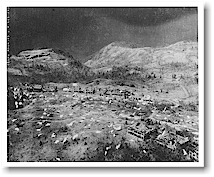
Parachutes
land on the US held side of the NCO Married Quarters. The Japanese held
the far side of the building. In the background (at left) is Battery
Cheney. Sunset Ridge is at far right.
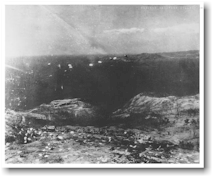
This stick of 8 paratroopers is heading for trouble, being blown back
over Japanese held territory. To the right is Sunset Ridge.
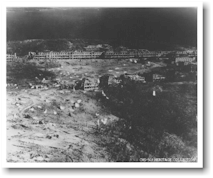
The area short of Landing Zone A; Battery Boston; Crockett Ravine ;
Officers Row.
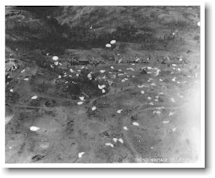
NCO's Married Quarters; Battery Wheeler; 3" AA guns; Battery Boston;
Battery Hearn; Hearn Magazine.
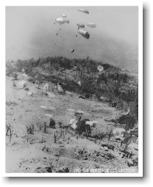
A stick of 7 drifts down.
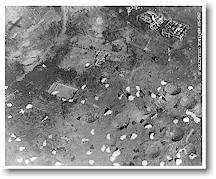
Landing Zone B, Golf Course, Officer's Swimming Pool, the Corregidor
Club, Senior Officers Row, Paratroopers visible in groups.
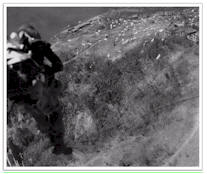
Jumpmaster's View; Landing
Zone A; Battery Wheeler, EM's Married Qtrs.; 27D; 28D; Battery Boston
|

Clearing the Island
Once Rock Force was ashore, operations on
Corregidor evolved into a large-scale mop-up. The size of the
island and the nature of the terrain precluded maneuver by units
much larger than a platoon, while the generally static and
disorganized defense of the Japanese led to a "campaign" of
small unit assaults. Colonel Jones's plan called for the 3d
Battalion, 34th Infantry, to secure Malinta Hill and contain the
Japanese on the eastern end of the island while the 503d
Infantry cleared Middleside and Topside. After the 503d's job
had been finished, Rock Force would overrun the tail. Within
this framework, operations proceeded in a series of generally
uncorrelated incidents.
On the afternoon of 17 February the 1st
Battalion, 503d Infantry, and other reinforcements reached
Bottomside by landing craft. Japanese rifle and machine gun
fire, most of which passed overhead, "expedited" the movement
ashore, and the battalion soon joined the rest of the regiment
on Topside. The troops already on Topside had spent the day
expanding their hold, systematically reducing the first of the
many Japanese bunkers, pillboxes, and underground defenses they
were to encounter, and had developed a pattern for the
destruction of the Japanese installations.
First, aircraft or naval fire support
ships--the air arm using napalm extensively--were called upon to
strike positions accessible to these types of bombardment; then
the infantry attacked almost as the last shell or bomb burst.
When this method failed, the 503d's own 75-mm. pack howitzers
and lesser weapons were brought forward for direct fire. Next,
having stationed men with submachine guns and rifles at advantageous points to cover approaches to a
Japanese position, infantry assault teams moved forward behind
white phosphorus hand grenades and the extremely close support
of flame thrower teams. To avoid backflash and assure the
deepest possible penetration of cave defenses, flame thrower
operators often projected their fuel unignited, and then used
white phosphorus grenades to fire it. If the Japanese within the
caves still could not be induced to give up the fight, engineer
demolition experts blocked the cave entrances.
One Japanese tactic was both advantageous and
disadvantageous to the 503d Infantry. Each night small groups of
Japanese would attempt to reoccupy positions cleared during the
previous day. To the 503d, this often meant some dirty,
repetitive work, and additional casualties. On the other hand,
the Japanese sometimes reoccupied tactically indefensible
positions that proved easy to take out. The 503d Infantry seems
to have been happy to let the Japanese occasionally return to
such positions, secure in the knowledge that the only result
would be more Japanese killed at no cost to the attackers. The
only way to keep the Japanese from reoccupying less vulnerable
positions was to stop night infiltration, a process that in turn
required the blocking of the underground passageways that
abounded on Topside.
By these methods Japanese casualties began to
mount rapidly. On the 17th, for example, over 300 Japanese were
killed; nearly 775 were killed the next day. In the same two
days Rock Force's casualties were approximately 30 killed and
110 wounded.
Apparently in an effort to redeem their
losses in a blaze of glory, Japanese at the southern and
southwestern sections of Topside attempted a counterattack in
the predawn hours of 19 February. Shortly after 0200 about 40
Japanese committed suicide by blowing up an ammunition dump a
few hundred yards north and inland from Breakwater Point,
simultaneously killing or wounding 15-20 men of the 503d
Infantry who, unaware of their danger, had been occupying a
building directly over the ammunition. About the same time
Japanese from Cheney Ravine and Wheeler Point, 800 yards
southeast of the ravine, started a ground counterattack that
reached its peak around 0600. The Japanese force, nearly 400
strong, pushed some of its troops all the way to the barracks
area on Topside, but the 503d Infantry finally drove them back
after 0800. 15 By
1100 the 503d had hunted down the last stragglers from the
counterattack and had resumed its daily process of small unit
actions against known strongpoints. Operations on the 19th,
including the events during the night, cost Rock Force over 30
men killed and 75 wounded, the Japanese nearly 500 killed. In
addition, the 503d had captured 3 Japanese, the first prisoners
of the battle.
The effort of the morning of 19 February was
the last major offensive action taken by the Japanese on
Topside, although small groups continued to execute un-co-ordinated
banzai attacks from time to time. Some Japanese officers
retained control of forces at the southwestern
corner, and here resistance continued to bear some semblance of
organization. The last significant opposition, centered at
Wheeler Point, ended with a small-scale banzai charge on the
morning of 23 February, and by 1800 that day the 503d Infantry
had substantially cleared the western section of Corregidor.
Colonel Jones could now direct Rock Force's full energies toward
clearing the area east of Malinta Hill, which the 3d Battalion
of 34th Infantry had held since the 16th.
The battalion had not been inactive at
Malinta Hill. The very first night ashore it had to beat off a
series of small but determined Japanese counterattacks along the
north side of the hill. In these skirmishes 10 Americans were
killed and a like number wounded, while about 35 Japanese lost
their lives.
On the 17th the battalion devoted most of its
time to securing the roads leading through Middleside so that
the wounded of the 503d Infantry could be evacuated and supplies
could be sent to Topside. Here, as on Malinta Hill and Topside,
much of the fighting involved the laborious process of cleaning
out small caves or, failing that, sealing them with explosives.
At Malinta Hill every night was marked by numerous small
counterattacks, executed by Japanese from Corregidor's tail or
from within the hill's tunnels. Everyone feared that at any time
the Japanese might set off tons of ammunition and explosives
known to be stored in the tunnels, and during the night 21-22
February the expected happened. At 2130 a deafening explosion
literally rocked the hill; flames shot out of tunnel entrances;
rocks and other debris flew in every direction; fissures opened
along the slopes; 6 men of Company A, 34th Infantry, were buried
alive by a landslide on the south side.
Apparently, the Japanese had planned a
controlled explosion to set the stage for a counterattack or to
allow the troops inside--now estimated to number 2,000--to
escape to the tail area in the ensuing confusion. If so, the
explosion had gotten completely out of hand, killing an unknown
number of Japanese within the tunnels. Troops of the 34th
Infantry killed other Japanese who counterattacked westward, but
several hundred Japanese did manage to make their way eastward
under cover of the explosion and the counterattack. Additional
explosions, apparently marking the suicide of Japanese still in
the tunnels, shook the hill during the night of 23-24 February.
Meanwhile, Rock Force had prepared plans for
the final assault against the east end of the island. The attack
was to be undertaken by the 1st and 3d Battalions, 503d
Infantry, while the regiment's 2d Battalion continued to mop up
at Topside and the 3d Battalion, 34th Infantry, continued to
hold Malinta Hill, Bottomside, and Middleside. Especially heavy
air and naval bombardment preceded the attack, which began on 24
February, and the 503d's light artillery laid down the heaviest
concentration of which it was capable.
The 503d's battalions first encountered
serious resistance at Engineer Point, off the northeast corner
of Malinta Hill, and when they overcame this they developed
still stronger opposition at Infantry Point, 800 yards eastward
along the north shore. Here some 600 Japanese attempted to
assemble for a counterattack, but 300 of them were killed by
artillery and infantry defensive
fires before the attack got well under way. The remaining
Japanese retreated eastward, and by nightfall on the 24th units
of the 503d held all but the last 3,000 yards of the tail. |
|
   |
|
|

|
|
|

